Learn about the benefits of constructing a multi-year internship from a MLIS student's perspective.

Pandemic photo voices
I think of a photo voice as a tool that encourages me to use visual images to reflect upon my experiences—a different, perhaps even more intuitive way to access how I am feeling and thinking. We can find photo voicing in many contexts including school projects, community-based action research, and grief work.
So perhaps this is a very appropriate platform for some of us to share what’s happening for us during this disruptive time of COVID-19.
I reached out to folks in different parts of our Ontario Library Association (OLA) community … north and south, east and west, OLA office and school libraries. And I also asked our international contributor, John Vincent, to share what’s happening for him in the U.K.
Last but not least, I was touched by Queen Elizabeth’s address to the people of Great Britain (and by extension the Commonwealth) so I included her as well.
Some of these voices were written early in the pandemic (like mine), while some have come in the last week. So clearly, our hearts and minds are evolving as we adjust to being distant from one another, our workplaces, and all the other social spaces that are so important to our “old normal” daily lives.
I was introduced to Amelia Earhart’s poem Courage at a very painful and despairing time in my life. I come back to it always when I feel the need to be uplifted and strengthened. Here it is and voices from our community.
Courage is the price that life exacts for granting peace.
The soul that knows it not
Knows no release from little things:
Knows not the livid loneliness of fear,
Nor mountain heights where bitter joy can hear
The sound of wings.
How can life grant us boon of living, compensate
For dull gray ugliness and pregnant hate
Unless we dare
The soul’s dominion?
Each time we make a choice, we pay
With courage to behold the resistless day,
And count it fair.
I invite you to share your photo voices for next month’s issue. After all, things will change and having an archive of our experiences will be important as we move forward.
Martha Attridge Bufton
Editor-in-Chief
Open Shelf
Photo by Serrah Galos on Unsplash
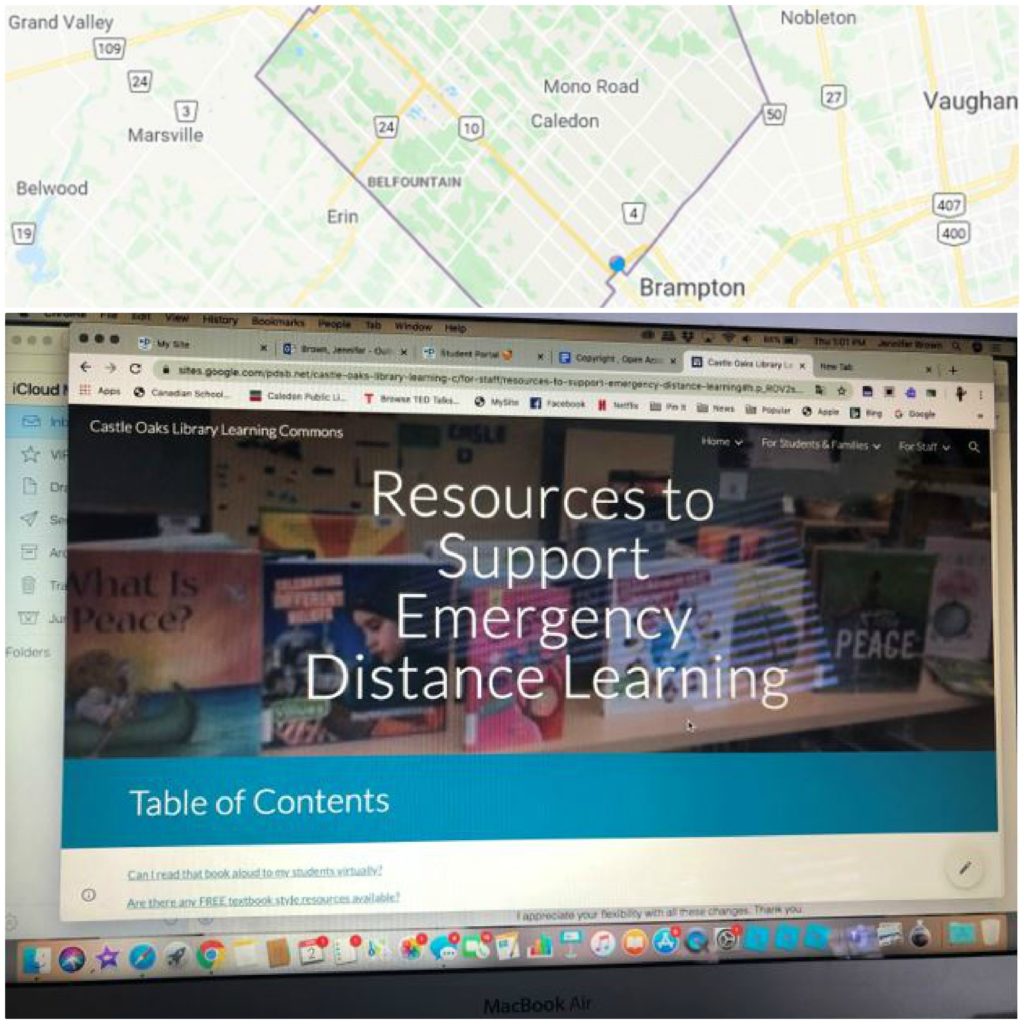 Privileged to be home, missing the kids
Privileged to be home, missing the kids
Jennifer Brown
Home community: Caledon
Workplace:
Castle Oaks Public School
Teachers can’t choose to work from home. We know that going in and we also know there are many other perks to our job that make not having the option of working from home no big deal. In fact, I love going into the beautiful library learning commons at my school so much that there are times I go back in the evenings with my own children to prepare new learning opportunities for the incredible students I serve. The impact of the school closures on our daily life cannot be overstated. Being in a two-teacher, four-student family means that we are all working and learning from home. We are privileged to be staying home with our family in a safe environment. Of the four members of our house who are employed, three of us are still receiving pay and benefits. Our house has enough space that we can “separate” from one another as needed. These privileges are not lost on me and to some degree they should negate the stress we are feeling. Now that the Ontario Ministry of Education has announced the official beginning of emergency distance learning, educators in Ontario are answering the call to connect with our students, create meaningful, albeit limited, learning experiences and consider how to equitably meet the needs of each child & their families.
For me, that means that in addition to reaching out to our students, my first task is to curate resources to support homeroom educators as they plan for literacy, numeracy, science & social studies in a way that most elementary teachers have never experienced. Gratefully, I had previously created a Google site for our library learning commons so adding a “one stop for all” type page for these resources was not challenging. New information is coming out daily and, truthfully, we aren’t sure what the next few days or weeks are going to look like for our students but we will continue to offer the best learning experiences we can while reminding them that their physical and mental wellness take precedence over everything.
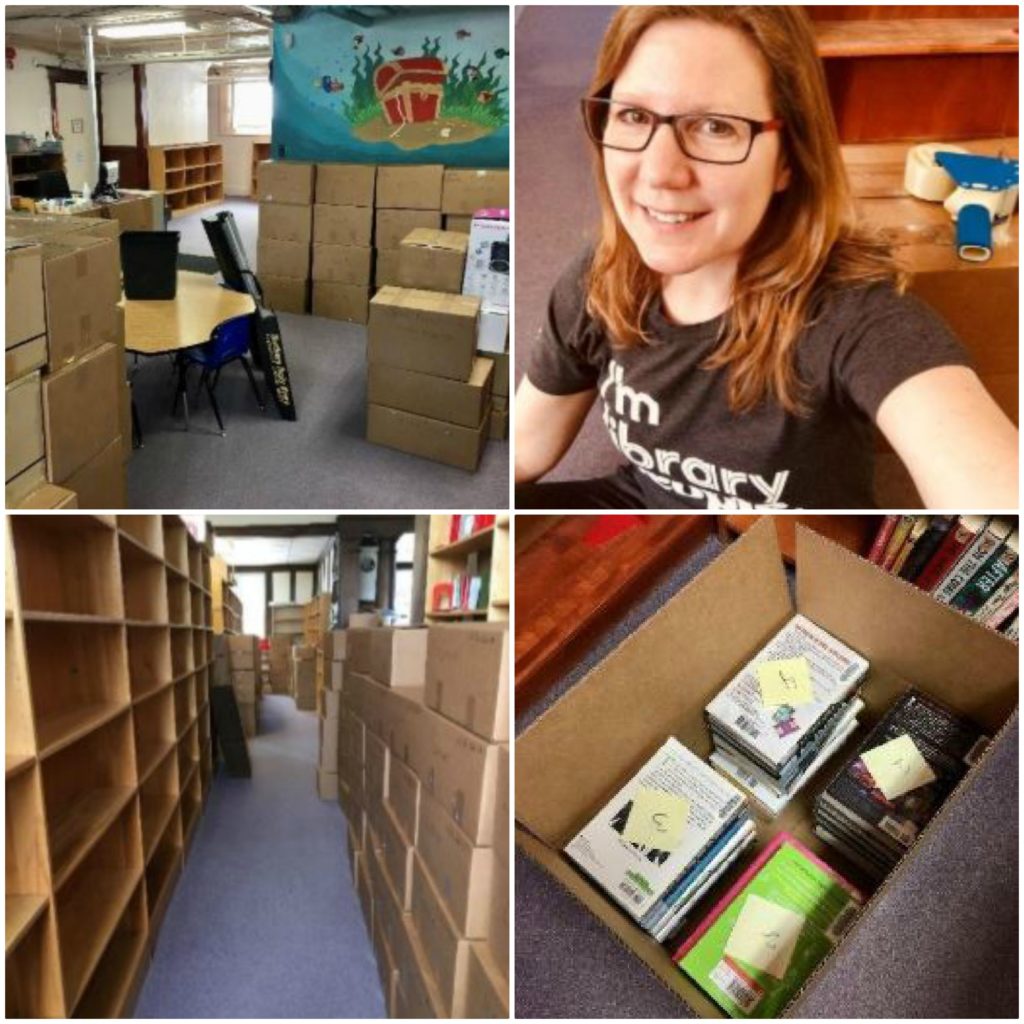 Making the best of a surprise closure!
Making the best of a surprise closure!
Rebecca Hunt
Home community: Temiskaming Shores
Workplace:
Temiskaming Shores Public Library
When the news came out in early March that extreme measures would have to be taken to slow the spread of the COVID-19 virus, the library here in Temiskaming Shores was just gearing up for a huge move that was to occur in April. When the library closed we quickly organized to pack the two library locations, in order to be prepared for the move when it can occur. At first we were able to have all of our full-time staff members help with the packing; however, the library board soon felt safer having most staff change to working from home. After a delivery of 850 boxes during a snowstorm on the last day of the full staff complement I continued to pack our entire collection with one other staff member—each of us on a separate floor of the library to avoid cross-contamination. Though we tried to make it fun—blasting our own favourite music on each floor and texting back and forth as we came across funny finds—we felt that we were racing against time.
On Monday, March 30, I completed the last bit of boxing up books alone in the beautiful old Carnegie library where I have spent the last 14 years of my career. I am thankful for many things during these uncertain times, among them are the great staff, library board and municipal staff with whom I work and the wonderful community in which I live, which is so very supportive of its library.
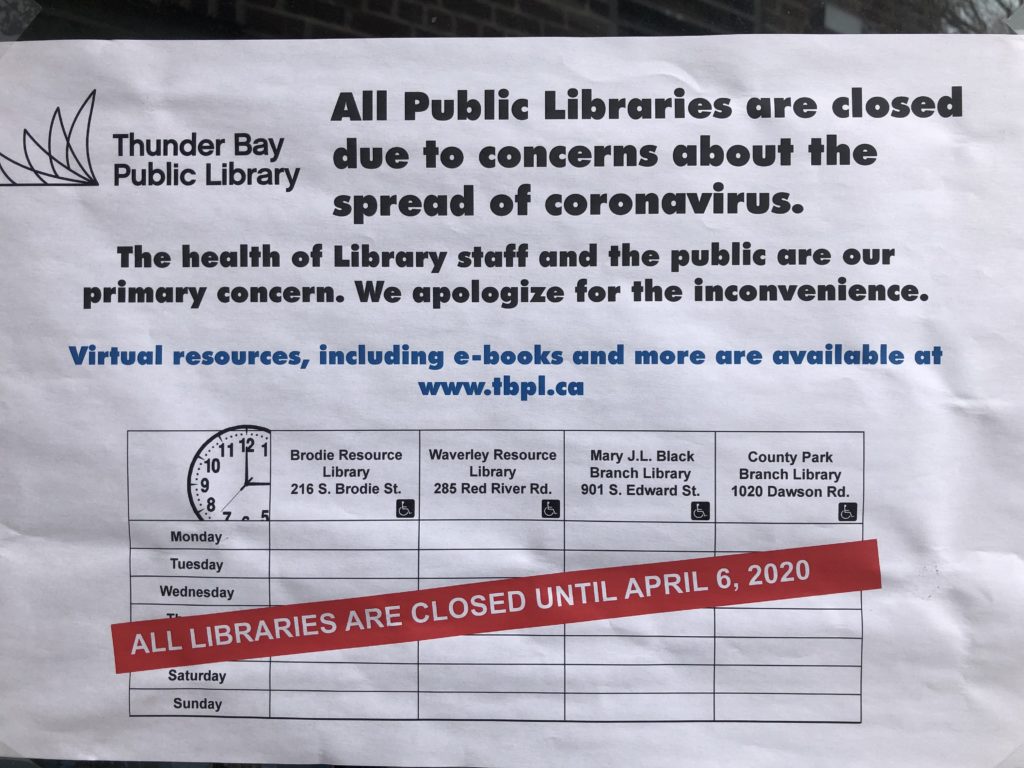 From stand-alone library to community hub
From stand-alone library to community hub
John Pateman
Home community: Thunder Bay
Workplace:
Thunder Bay Public Library
This pandemic is creating social distancing and self-isolation which strike at the heart and purpose of the public library. The library exists to provide democratic public space and free shared resources that people can use collectively. This virus represents the highest stage of capitalist individualism. The antidote is socialism. When the crisis is over the people will not want to go back to the old ways of working. The people will demand more investment in public services such as health care and the public library. The people will also demand changes to the public library. This will mean that the traditional stand-alone library is transformed into a needs-based, multiple-purpose community hub.
This will require a shift in or abandonment of white middle-class professional library values. The library truly must be open to all if it is to meet the needs of a post-pandemic world.
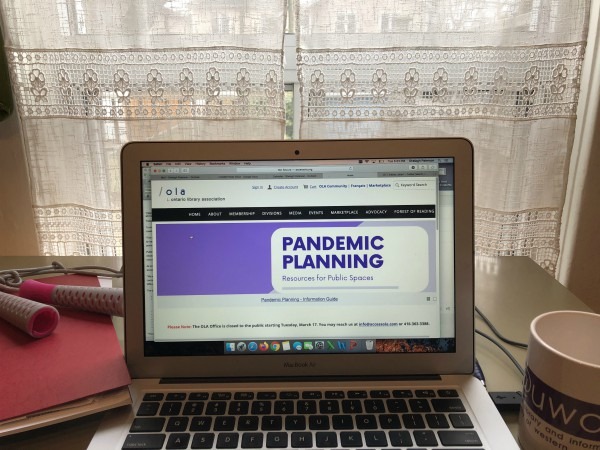 Resourcefulness and compassion
Resourcefulness and compassion
Shelagh Paterson
Home community: Toronto
Workplace:
Ontario Library Association
Pictured here is my workday in a snapshot. On the left is my skipping rope. I start each day with 17 minutes of skipping (I use my egg timer) in the teeny laneway between houses. This is to get me energized to make the trek to my kitchen office. Behind the curtain is my postage-stamp deck where I scatter seeds and watch the blue jays, cardinals and sparrows who serve as my mini-break diversions. I have the laptop open to OLA’s website to represent the amazing work of the OLA staff team. They are tracking what is going on with everyone, sending out communiqués, brainstorming ways to connect, and revisiting all of OLA’s educational offerings including promotion of the Education Institute and exploring virtual event options. Last Friday afternoon we met for “Quarantini Time” using Microsoft Teams.
While working from home works I miss seeing the staff team and the steady stream of OLA members. We have approximately 500 member visits to our office annually. This is a stressful time for everyone and we are seeing incredible compassion and resourcefulness from the library sector.
Queen Elizabeth
Home community: The United Kingdom
Workplace:
Buckingham Palace, Windsor Castle, the Commonwealth
Home community: The United Kingdom
Workplace:
Buckingham Palace, Windsor Castle, the Commonwealth
 Glad of some distance …
Glad of some distance …
John Vincent
Home community: Nadderwater, Exeter, U.K.
Workplace:
Home—and all over the U.K.
My partner and I moved here in 1994—we were looking for somewhere that was close to a city (Exeter) but also far enough away to have some quiet and space to garden. I work from home some of the time, but also run courses, go to meetings, deliver projects all over the U.K. In this strange and grim time, we are both working from home and glad that we have friends and neighbours nearby—but also have some sense of distance. Thankfully, there is quite a lot that I can be getting on with (in fact, probably, more than enough!) at home, so am catching up with some writing, and am about to start uploading content to a website to support Libraries of Sanctuary (public libraries that welcome sanctuary seekers).
In addition—which is why I have chosen this photo—we’ve been taking the opportunity of having good weather at last, plus almost no traffic in our lane, to do some pruning and clearing work that we would normally have done in the autumn but couldn’t because of the wet weather. This is the result, looking in one direction!
The one thing that has stood out for me over the last month or so is how kind people have been—people asking if we need anything, people stopping for chats (at a distance), delivery people making sure that things get through to us. When we are able to restart our social lives, let’s see if we can retain some of that.
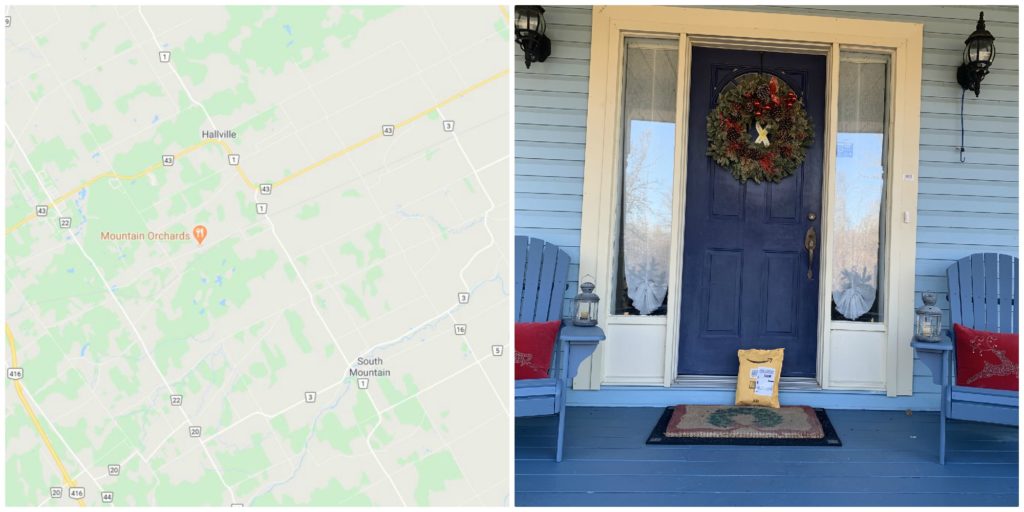 Grateful for space (and parcel delivery)
Grateful for space (and parcel delivery)
Martha Attridge Bufton
Home community: Hallville
Workplace:
Carleton University
When my husband and I moved to Hallville (a hamlet with a population of maybe 350?), we were happy with the distance between ourselves and our neighbours. And we have lots—certainly more than when we lived in an end condo unit near the Ottawa International Airport. We were also happy that we had a mailbox at the end of our driveway and parcel delivery to our front doorstep. Letter and package delivery does much to mitigate against a sense of social isolation. I took the photo on the right on Sunday, March 22 and realized that I am no longer surprised that Amazon delivers almost everywhere, anytime. I did feel more isolated when our Wi-Fi service came through a dial-up modem. But, since 2014, we’ve had high-speed internet in our pocket of rural eastern Ontario, so my sense of being connected to family, friends, and colleagues who live and work elsewhere is much stronger now. And I confess that I love working from home … less noise of all kinds with which to contend and I feel more in control.
So the current public health measures to slow and stop the spread of COVID-19 have not (as yet) posed any emotional or psychological problems for me. I am still able to do the core parts of job—teaching, collections, and outreach—and I’m very fortunate that this quarantine is not having a negative impact on my income, my health, or my primary relationships—luck is on my side this time. Will I want to be back on campus in [fill in the blanks] months’ time? Sure. And yet, right now I am grateful for a bit of space.


